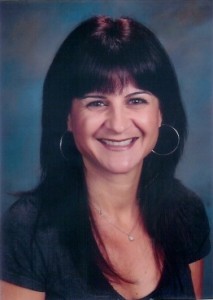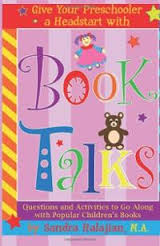Our Literacy Guest Spotlight Q & A continues this month. If you are joining us for the first time, WELCOME! Each month we travel around the world interviewing people who are passionate about literacy and young children. This month we are talking to Sandra Halajian, the author of Book Talks. Let’s get talking!
Sandra, tell us a little about yourself.
I am a mom and an educator (and of course a wife to a wonderful husband). My daughter is a freshman in high school and my son is in seventh grade. I enjoy motherhood tremendously. I also LOVE teaching. I discovered my passion in teaching when I became an elementary school teacher’s assistant. After college, I became an elementary school teacher, and soon after, I earned my secondary school credential and began teaching English in high school. Before my daughter’s birth, my husband and I decided that I would stay home and raise her and later her brother. That’s when I began developing a parenting workshop focusing on reading. At first, I did my own research and eventually went back to school part time to earn a Reading Certificate. Once my daughter started kindergarten, I decided to go back to teaching high school English. After about eight years of teaching, I decided to take a much needed hiatus and work on my writing. I revised the preschool workshop materials I had developed and published Book Talks in December of 2012. I also created and published lesson plans for teachers on a website called TeachersPayTeachers.com. Currently, I’m working on my next parenting guide, so parents can help their children succeed in school.
You have published a book called Book Talks. Tell us about the book.
The (very) long title of the book is Give Your Preschooler a Headstart with Book Talks: Questions and Activities to Go Along with Popular Children’s Books. It’s a parenting handbook for parents of 2 to 6 year olds. It introduces the importance of reading aloud to young children, and more importantly, to engage them in questions and activities before, while, and after you read a book. I’ve picked the 20 most popular and educational books that many parents either have at home or can check out from the library, like Goodnight Moon, Brown Bear, Brown Bear What do You See?, The Very Hungry Caterpillar, and We’re Going on a Bear Hunt. I also included a few that they might not have heard of, but that have captivating plots and allow kids to make great predictions. I’ve developed questions and activities for each book, and I encourage parents to pick a few questions or to do an activity with their kids. The point is to build children’s early literacy and critical thinking skills. When my kids were very young, I would make up questions and activities as if I was their preschool teacher, and that’s where the idea came from. Many teachers use the “before, during, after” strategy to plan their lessons, and research shows it works by increasing children’s reading comprehension, expanding their vocabulary, and improving their higher order thinking skills.
You also have a blog that correlates with your book. Can you share a few of your favorite posts with us?
The blog provides an overview of the book. Parents can also see a sample of a “Book Talk” for Brown Bear Brown Bear, What Do You See?, as well as look at the book’s “Table of Contents.” I also try to blog as often as I can on issues relating to reading readiness, literacy, and preschoolers. One of my favorite posts explains to parents how children learn to read (“How Kids Learn to Read and What You Can Do to Help” posted on January 25, 2013). Many parents believe that kids learn to read through some kind of “phonics” programs, but that’s not entirely true. When my kids were in preschooler, and I became more and more interested in reading comprehension, I learned that phonics is only a small component of reading and not necessarily the most important part. Reading is a complex task, but there are so many easy things parents and caregivers can do in the early years—before kids actually learn to read letters and words—to insure that their kids become good readers by the time they reach third grade. So, the post discusses the two main components of reading and provides suggestions for parents on reading readiness.
Another blog post that I like is divided into two parts: “The Truth about Screens” (Part 1 and Part 2). I am always struggling to limit “screens” (TV, computer, iPod, Xbox, smart phone, etc.) with my kids, and I limited their use when they were very young, and I’m so glad that the research backs this up. In fact, when my daughter was in kindergarten, the rule was no “screens” during the week, and that saved me from many battles, and it was the BEST thing I did. Of course, as my kids got older, the rules slightly changed, but I continue to monitor and discuss with them both the benefits and harmful effects of screens. I personally think technology has great benefits, but kids can easily waste a lot of time on them and get hooked if we don’t set limits. I would love to hear what other parents think about this issue and what advice they have for parents. My blog can be found on booktalks4preschoolers.com. I also encourage parents to look at reviews of my book on Amazon if they are interested to know what other parents have to say.
What are two of your favorite books for preschoolers?
That’s a tough question! There are so many I love. And it’s amazing how beautifully illustrated and poetic many children’s books are. I adore We’re Going on a Bear Hunt by Michael Rosen. It has a very silly plot, but it’s hilarious and very engaging. My kids and I had memorized all the words. It’s very repetitive and rhythmic.
I also love Chicka Chicka Boom Boom by Bill Martin, Jr. and John Archambault. The letters of the alphabet run up a palm tree and eventually fall down. It teaches kids the alphabet with lots of rhymes. You have a background in reading comprehension.
What’s the best advice you can give caregivers in regards to reading comprehension?
Take kids to the library on a regular basis and to preschoolers’ reading time. Also, surround them with all kinds of reading materials at home. Have them notice letters and words on cereal boxes, in the supermarket, and on the streets. I suggest parents and caregivers read to their children every day or at least three times a week, and not just during bedtime. And if they have more time, ask them a few questions about the book. Keep it fun!
Do you have any literacy rituals in your family?
We did when my kids were in preschool and in elementary school. We had family reading time at least three times a week; it was usually after dinner for about 20 minutes. All four of us set in the living room and read a book, a magazine, or a newspaper without any interruptions.
For longer trips in the car, we listened to books on tape (or CD). I checked them out from the library with two copies of the book, so my kids can follow along by looking at the illustrations.
Getting To Know You A Little Bit More…
If you could have brunch with three characters from children’s literature, who would you invite?
I would invite Harold (from Harold and the Purple Crayon), and I would give him a crayon to draw on my walls. I would also invite Peter (fromThe Snowy Day) and Pig (from Pigs Can’t Fly). We would spend hours talking about their amazing adventures while gobbling pies (Harold’s favorite).
Hardcover or e-book?
I’m old school. I can’t seem to get used to e-books. I love the feel of books, and to really appreciate the artistic beauty of the illustrations, you need to see them closely and touch them in print form. Plus, I enjoy reading nonfiction, and I like writing or annotating on the margins of the books.
What is a fond childhood memory you have?
Going to the beach was (and still is) my favorite outing as a child. My sister and I played in the sand for hours. I loved collecting seashells and unusual pebbles.
Where is your favorite place to read a book?
Of course, at the beach. But when I’m not at the beach, I like to read in bed when the house is finally quiet. Strangely, I also enjoy reading in the car while I’m waiting to pick up one of my kids from school or from an afterschool activity.
What book is on your nightstand or e-reader now?
On average, I read two books at a time. If I really enjoy a book, I’ll reread it or go over my notes and reread sections. I mostly read nonfiction. I am now rereading Geography of Bliss by Eric Weiner. He takes you on a journey around the world looking for the happiest (and sometimes most miserable) places. His writing is humorous and often self-deprecating. (I’ve also enjoyed reading his second book Man Seeks God).
Plus, I’m reading Daniel Coyle’s The Talent Code: Greatness Isn’t Born. It’s Grown. Here’s How. I think the title says it all. I’m trying to help nurture my kids talents and passions
Sandra, thank you for sharing your expertise with us. We wish you continued success with your book!
Join us again next month when we chat with another guest passionate about literacy.

